In his campaign for mayor of New York City, Bill de Blasio positioned himself as the candidate most determined to break with the legacy of the outgoing Michael Bloomberg administration. Voters responded enthusiastically, handing de Blasio a nearly 50-point margin of victory in the November 2013 election. De Blasio, a Democrat, interpreted the win as a broad mandate for change, calling in his inaugural address for “a new progressive direction” that would “put an end to economic and social inequalities that threaten to unravel the city we love.”
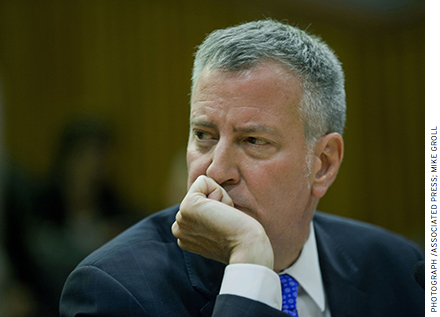
Public education, a top priority of the Bloomberg administration, was one of several areas where de Blasio promised big changes. De Blasio has pledged to maintain Bloomberg’s focus on closing the achievement gap, but his education agenda has revised the means: turnarounds instead of closures, heavy emphasis on addressing the “root causes” of K–12 underperformance through pre-kindergarten education and social services, less antagonistic relations with the United Federation of Teachers (UFT), and more-relaxed school-discipline policies.
But the results have been something less than revolutionary. De Blasio’s first three years in office attest to the significant constraints progressives across the country will face in trying to roll back education reform, even when faced with no significant political opposition at the local level. These constraints stem from state government’s role in education policymaking, limits on available resources, and tensions within progressivism itself. All of them will likely continue to frustrate de Blasio and other progressive mayors in their attempts to develop an alternative to the education-reform agenda.
Accountability Gaps
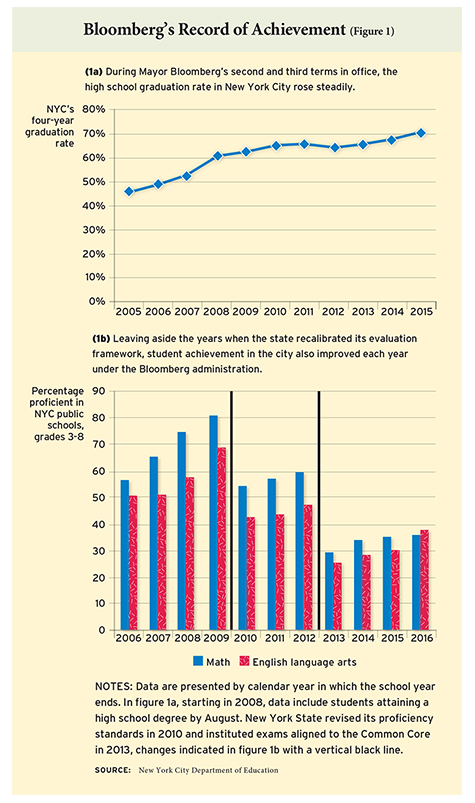 Mayor Bloomberg, a Republican-turned-Independent, left an impressive record of achievement on school reform that contributed substantially to New York City’s shedding its reputation as the “ungovernable city.” The graduation rate rose by more than 20 percentage points and, leaving aside the years when the state recalibrated its evaluation framework, student-achievement rates in the city improved annually (see Figure 1). From 2003–13, 4th- and 8th-grade National Assessment of Educational Progress (NAEP) scores rose in both reading and math at rates far outpacing those of the rest of the state and, in some cases, the nation as a whole (see Figure 2). On state tests, New York under Bloomberg gradually reduced the student proficiency gap between the city and the rest of the state in both English language arts (ELA) and math.
Mayor Bloomberg, a Republican-turned-Independent, left an impressive record of achievement on school reform that contributed substantially to New York City’s shedding its reputation as the “ungovernable city.” The graduation rate rose by more than 20 percentage points and, leaving aside the years when the state recalibrated its evaluation framework, student-achievement rates in the city improved annually (see Figure 1). From 2003–13, 4th- and 8th-grade National Assessment of Educational Progress (NAEP) scores rose in both reading and math at rates far outpacing those of the rest of the state and, in some cases, the nation as a whole (see Figure 2). On state tests, New York under Bloomberg gradually reduced the student proficiency gap between the city and the rest of the state in both English language arts (ELA) and math.
The city clearly has room for improvement, given its pockets of deep underperformance: the most recent round of state-test results found that 15 percent or fewer of the city’s students are proficient in ELA in 145 schools and in math in 271 schools. And New York’s NAEP scores place it only in the middle of the pack among large urban school systems. But aside from a slight drop-off in NAEP 4th-grade reading and math scores, the overall upward trends put in motion under Bloomberg have continued through de Blasio’s first term. A February 2016 analysis by the Independent Budget Office found that New York’s district and charter schools outperform the rest of the state when ethnic and economic variables and disability rates are accounted for. And in the spring 2016 round of state testing, the city’s 3rd through 8th graders caught up to the rest of the state in ELA, notching a 38 percent proficiency rate compared to 37.9 percent statewide. (In math, the respective numbers were close, at 36.4 percent and 39.1 percent.)
When de Blasio took office, many critics doubted that his background as an activist and minor local official had prepared him for the awesome administrative challenges of Gotham’s mayoralty. De Blasio tried to address his lack of executive experience by relying less than Bloomberg did on outsiders to staff his administration. De Blasio’s schools chancellor is Carmen Fariña, a 50-year veteran of New York education policy. Though Fariña worked as a deputy chancellor in the Bloomberg administration, her management philosophy differs sharply from that of Bloomberg’s chancellor, Joel Klein, in significant ways. She is far less data-driven, as a favorable profile in the New York Times pointed out, and she takes great pride in taking a collaborative approach to running the city’s Department of Education (DOE).
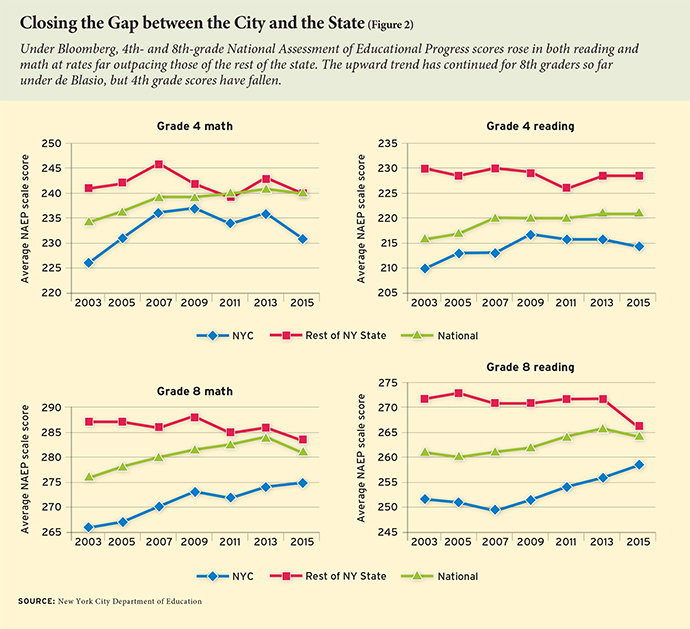
Relations with the UFT have become far more collegial under de Blasio than they were under Bloomberg. According to the Wall Street Journal, UFT president Michael Mulgrew visited de Blasio more than any other registered lobbyist during his first two years in office. Six months after becoming mayor, de Blasio settled a new contract with the UFT, stretching from the last three years of the Bloomberg administration past the 2017 mayoral election. The de Blasio administration neither attained nor sought significant concessions from the UFT on fiscal matters or workforce rules. Including retroactive raises, teacher pay will increase by $9 billion over nine years. For the city, the net impact will be billions more: under New York’s “pattern bargaining” approach to contract negotiations, the generous deal with the UFT, the city’s largest bargaining unit by far, set the framework for the dozens of other municipal unions.
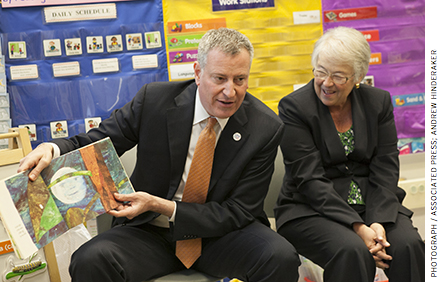
De Blasio’s reluctance to bargain harder with the UFT was partly political, but also likely rooted in his ideological sympathies with organized labor (although the UFT did not endorse de Blasio in the Democratic primary). Whatever the motives, collegiality comes at a cost. Satisfying union demands will limit the resources available for progressive priorities in education and other areas. For example, de Blasio argued that universal full-day pre-K, his marquee education initiative, would be more secure if locally funded. De Blasio could easily have paid for the $340 million pre-K expansion in the program’s first year, and most of the ongoing cost in subsequent years, by requiring teachers and other city workers and retirees to contribute 10 percent to their health insurance premiums (amounting to nearly $550 million, according to the Independent Budget Office). Instead, he tried to raise city income taxes—a move blocked by Governor Andrew Cuomo. Thanks to the health of the local economy, the de Blasio administration has been able to paper over this tension between labor harmony and the expansion of government services, but that does not make it any less real.
Fariña and de Blasio’s collegial approach to managing the DOE, and their lack of interest in data-oriented policymaking, have caused them to weaken accountability frameworks that Bloomberg put in place. In 2007, the Bloomberg administration rolled out a system of “School Progress Reports”—report cards for schools that assigned A–F letter grades. But as part of the mayor’s plan to “lower the stakes on testing,” the de Blasio administration replaced the report cards with a “School Quality Report” system, which is based on similar metrics but does not give schools a letter grade. In a recent analysis, my colleague Marcus Winters compared the final batch of School Progress Reports with the 2014 de Blasio School Quality Reports to see if F-quality schools notched as much progress without the letter grades as with them. He found that “improvement dissipated immediately after summary letter grades were dropped.” This conclusion comports with research about the motivating effects of school report cards that Winters and others had published long before de Blasio and Fariña made their decision to eliminate the Progress Reports.
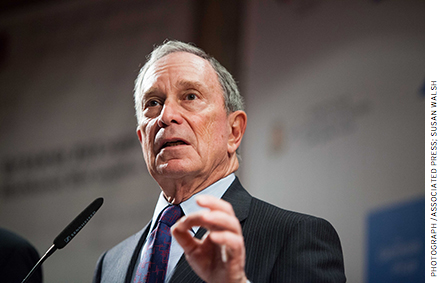
a system that helped motivate improvement.
The perception that de Blasio has made the DOE less accountable may have contributed to his failure to gain a multiyear extension of mayoral control of the schools. In general, mayoral control enjoys broad support in New York City: even the mayor’s most strenuous critics don’t advocate a return of the pre-Bloomberg Board of Education, whose members were not directly elected but appointed by other local officials. But mayoral control must be reauthorized by the state legislature, and twice de Blasio has been forced to settle for one-year extensions of this authority rather than the permanent and seven-year extensions he sought in 2015 and 2016, respectively. Many observers view de Blasio’s losses on mayoral control as motivated by political payback by state senate Republicans, whose dominance in the legislature’s upper chamber de Blasio tried unsuccessfully to end during the 2014 election cycle. Scott Reif, spokesman for Senate Majority Leader John Flanagan, disputes this analysis: “The decision to provide a one-year extension of mayoral control was based solely on the merits and nothing else,” Reif said. “At the end of the day, our only motivation is what’s in the best interest of the 1.1 million students who attend New York City schools and their parents.”
School Discipline Reform
De Blasio has also weakened school discipline rules and procedures. With the vocal encouragement of the Obama administration, de Blasio, like other urban progressives across the nation, has recently put forth a raft of changes aimed at ending the so-called cradle-to-prison pipeline. Suspensions had already been on the decline during the last three years of the Bloomberg administration (see Figure 3), but de Blasio’s DOE has placed further restrictions on their use. For example, in April 2015, the de Blasio administration changed the DOE’s discipline code to require principals to get approval from central administration before suspending a student for defiant or disobedient behavior. This move runs counter to the notion of principal autonomy, a long-sought goal of many education reformers. But from another perspective, a progressive school-discipline policy is the logical extension of education reformers’ achievement-gap philosophy. While below-proficient students are believed to benefit the most from a lower suspension rate, those who have the most to lose are the above-proficient, low-income strivers.
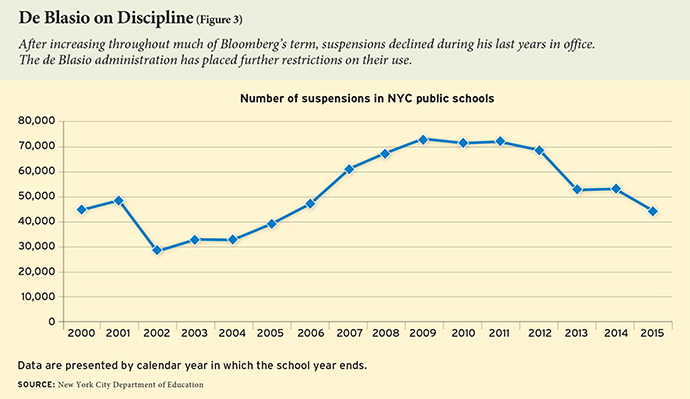
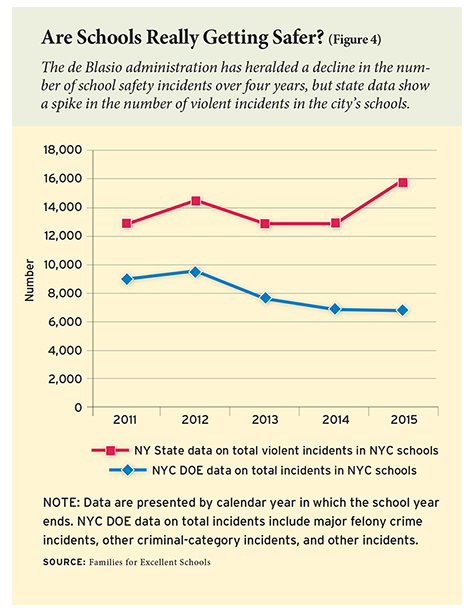 Opposition to de Blasio’s innovations on school discipline has centered around the empirical question of whether schools are getting safer under the “restorative justice” regime. The administration has heralded a 29 percent drop in school crime over four years, but the organization Families for Excellent Schools has put forth other studies based on state data that have shown rising levels of violent incidents in city schools (See Figure 4). An August 2016 announcement that the number of “Persistently Dangerous” schools, a state designation, had dropped by 85 percent to only four citywide was met with skepticism by the head of the school-safety agents union, who pointed out that not a single high school had made the list. In May 2016, the New York Post reported that school-safety agents and police officers had confiscated 26 percent more weapons from students during this past school year than over the same span in 2014–15. (Phasing out metal detectors, first installed during the late 1980s crack epidemic, is a priority of the de Blasio administration’s school-discipline task force.)
Opposition to de Blasio’s innovations on school discipline has centered around the empirical question of whether schools are getting safer under the “restorative justice” regime. The administration has heralded a 29 percent drop in school crime over four years, but the organization Families for Excellent Schools has put forth other studies based on state data that have shown rising levels of violent incidents in city schools (See Figure 4). An August 2016 announcement that the number of “Persistently Dangerous” schools, a state designation, had dropped by 85 percent to only four citywide was met with skepticism by the head of the school-safety agents union, who pointed out that not a single high school had made the list. In May 2016, the New York Post reported that school-safety agents and police officers had confiscated 26 percent more weapons from students during this past school year than over the same span in 2014–15. (Phasing out metal detectors, first installed during the late 1980s crack epidemic, is a priority of the de Blasio administration’s school-discipline task force.)
The school discipline discussion has paralleled the wider debate in urban America over “broken windows” or “quality of life” policing, which entails aggressive enforcement of low-level crimes if they threaten to disrupt the social order—vandalism, turnstile jumping, public drinking, and the like. In schools, the analog to such policies is a “zero tolerance” discipline code, in which school officials crack down on even “low level” offenses such as defiance, minor physical contact, and inappropriate language, because of the potential consequences of such behavior on other students and their learning. According to one recent UFT survey of its members, “more than 80 percent of the respondents said students in their schools lost learning time as a result of other disruptive students.” Though school discipline reform is an imperative for the most ideological progressives, the debate over the issue has revealed some rifts within the de Blasio coalition.
Turnaround Strategies
Closing down large, chronically low-performing schools and replacing them with a greater number of smaller, new schools was central to Bloomberg’s expansion of school choice and his overall approach to the achievement gap. Dismissing studies that found that it had benefited students, de Blasio characterized Bloomberg’s closure policy as “an excuse not to address ways to help struggling schools improve and meet our expectations that all students graduate ready for college or a career.” Instead, he has invested in two overlapping turnaround programs: the Community Schools Initiative and the School Renewal Program. The latter supplements struggling schools’ per-pupil outlays, funds additional teacher training and summer school, and will add another hour to the school day. In some extreme cases, Fariña has counseled out ineffective teachers, and three schools, plagued with rapidly declining enrollment, have been closed. The Community Schools Initiative proposes to boost student achievement by providing struggling schools with wraparound social services via city-sponsored partnerships with neighborhood organizations. (There are 94 Renewal schools and 130 Community schools. All Renewal schools are Community schools but not all Community schools are Renewal schools.)
The de Blasio turnaround programs have suffered from a certain lack of urgency, and their scope is both too broad and too narrow. As the education news website Chalkbeat has documented, it took 10 months for the initial announcement of the programs, many schools received only cursory assistance during the 2014–15 school year, and progress metrics were not released to the public until December 2015. Initial estimates of the three-year cost have swelled from $150 million to $400 million. This is a significant sum, but the Harlem Children’s Zone, a much-admired model for Community Schools, runs its two Promise Academy schools and the related network of community services on an annual budget of $100 million (see “How Family Background Influences Student Achievement,” features, Spring 2016). Rather than a scaled-up version of the Harlem Children’s Zone, de Blasio’s turnaround efforts resemble dozens of much more modest versions of the model. At the same time, as the reform-advocacy group StudentsFirstNY has pointed out, many city schools that are very low-performing based on the administration’s own metrics are not even included in the turnaround programs.
Thus, de Blasio’s turnaround efforts are hampered by more than just unforced errors of execution. Concentrating resources is likely to be more effective, but spreading resources more widely will enjoy more political support. Either way, a focus on “root causes” is expensive, and urban America’s resources will be quite limited for the foreseeable future. A 2015 report by the National League of Cities found that the revenues of cities across the country had yet to fully recover since the end of the recession. Revenue growth has been outpaced by rising expenditures associated with cities’ trillion-dollar-plus retirement benefit liabilities. (Unlike federal officials, mayors are subject to local balanced-budget requirements.) It is not remotely practical to authentically replicate the Harlem Children’s Zone model for every struggling school. To the extent that the progressive alternative to education reform relies on increased spending, it will always be a work in progress.
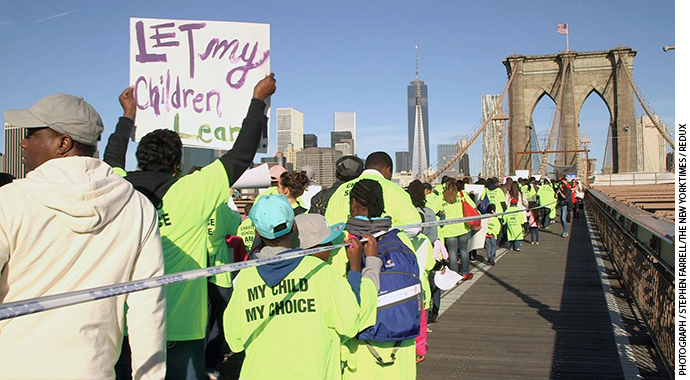
Cuomo, Pre-K, and Charters
Though the 2017 election cycle has yet to kick into high gear, de Blasio has already made clear that he believes he deserves a second term largely on the strength of having established “universal, high-quality, full-day” pre-K in New York. When de Blasio took office, about 20,000 children had access to government-funded full-day pre-K. In the 2015–16 school year, that number has grown to 69,000. Like Community Schools, pre-K focuses education policy away from elementary and secondary school classrooms toward root causes. With an achievement gap in numeracy and literacy already evident by the time children begin kindergarten, progressives nationwide believe that a massive investment in preschool will compensate for disadvantages related to students’ poverty status and family background. In making pre-K universal, de Blasio has here, too, opted for a broad distribution of resources over a more concentrated one. In an interview with Politico New York, Richard Buery, the administration’s lead on pre-K, justified the need for universality by arguing for the importance of “diversity” and claiming that “from a political perspective, universal programs are easier to maintain over the term, [and] there’s a broad constituency for early childhood education.”
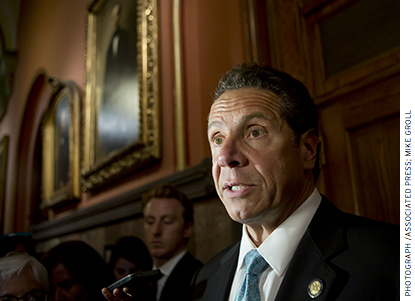
access to facilities funding for New York City charter schools is now more secure than ever.
Bruce Fuller, professor of education and public policy at the University of California, Berkeley, questions this argument. He points to research he and others have done showing that children from low-income families are the ones who derive the most benefit from public pre-K. “Given scarce resources,” he tells me, “government should fund kids in the families where the effects are discernible-to-large, and that means focusing on poor kids.” Fuller has put out a series of reports about the de Blasio program, finding, among other things, that new pre-K seats have been disproportionately concentrated in affluent neighborhoods. He estimates that 12,000 children in poor neighborhoods still lack any access to a public pre-K program.
The state has played an important, if questionable, role in bringing universal full-day pre-K to New York City. De Blasio’s initial proposal was to expand pre-K by imposing a 0.5 percent surcharge on incomes above $500,000. About forty thousand tax filers would have seen their annual bills go up by an average of $12,000. But New York’s taxing power, like all other cities’, is regulated by state government. Governor Cuomo rejected de Blasio’s tax proposal, instead locating funds in the state budget to fund the pre-K expansion. Thus, while the cost of universal pre-K in New York City is $863 million, local revenues cover only $112 million, according to a recent analysis by the nonprofit Citizens Budget Commission. As mentioned earlier, the most optimal funding scenario would have seen de Blasio cut spending elsewhere in order to fund pre-K. The second-best choice would have been for the city to raise taxes citywide to pay for the service expansion. Cuomo’s approach allowed New York City to get something for nothing, and may have diverted attention from the relative benefits of “universal” versus targeted pre-K.
On charter schools, Cuomo has played a much more constructive role. During Bloomberg’s three terms, charter schools expanded by more than 600 percent, a rate six times that of the nation as a whole during the same time span. Because real estate is at such a premium in renaissance New York, the Bloomberg-era charter expansion was facilitated by co-location, the practice of giving charters unused space in district school buildings. On the campaign trail, de Blasio criticized this policy, saying, “There’s no way in hell Eva Moskowitz should get free rent,” referring to Moskowitz’s Success Academy charter network (see “What Explains Success at Success Academy?” features, Summer 2015). De Blasio does not question charter schools’ right to exist and has a number of personal connections to independent charter operators. But because of their ambitious plans for growth and their connections to Wall Street, charter networks seemed to be on a collision course with the de Blasio administration shortly after the 2013 election.
Surprisingly, though, thanks to the intervention of state government, access to facilities funding for New York City charter schools is now more secure than ever. During the FY’15 budget cycle, Cuomo and the state legislature passed a law requiring the city to either accommodate new or expanding charters in district buildings or provide them with rental assistance. Lobbying played an important role here, no doubt. Pro-charter groups have in some years outspent the UFT and New York State United Teachers, longtime dominant forces on the state scene. And increased political support has been an effect as well as a cause of charter school expansion. According to the New York City Charter School Center, charter school enrollment now tops 100,000 students, with another 43,000 on waitlists. In Harlem, charters now enroll more than a third of all youngsters in public schools. But since the city’s progressive ruling class remains tepid at best on charters, it took the intervention of Cuomo and the legislature to translate this political support into policy.
What Lies Ahead?
It’s early yet—Bloomberg had 12 years in office, and de Blasio has thus far been in charge for only two full school years. However, though de Blasio may lack effectiveness as an executive, the challenges he has faced in rolling back education reform should not be attributed only to the gap between his progressive ideals and his administrative competence. The role of the state, budgetary limitations, and an inability to say no to union demands will limit progressive mayors’ power over education policy in the future, both in New York and in other cities. A viable progressive alternative to Bloomberg’s education-reform agenda has yet to emerge.
Stephen Eide is a senior fellow at the Manhattan Institute. His work focuses on public administration, public finance, political theory, and urban policy.
This article appeared in the Winter 2017 issue of Education Next. Suggested citation format:
Eide, S. (2017). Ed Reform Rollback in New York City: Mayor De Blasio’s Efforts Remain a Work in Progress. Education Next, 17(1), 26-34.


